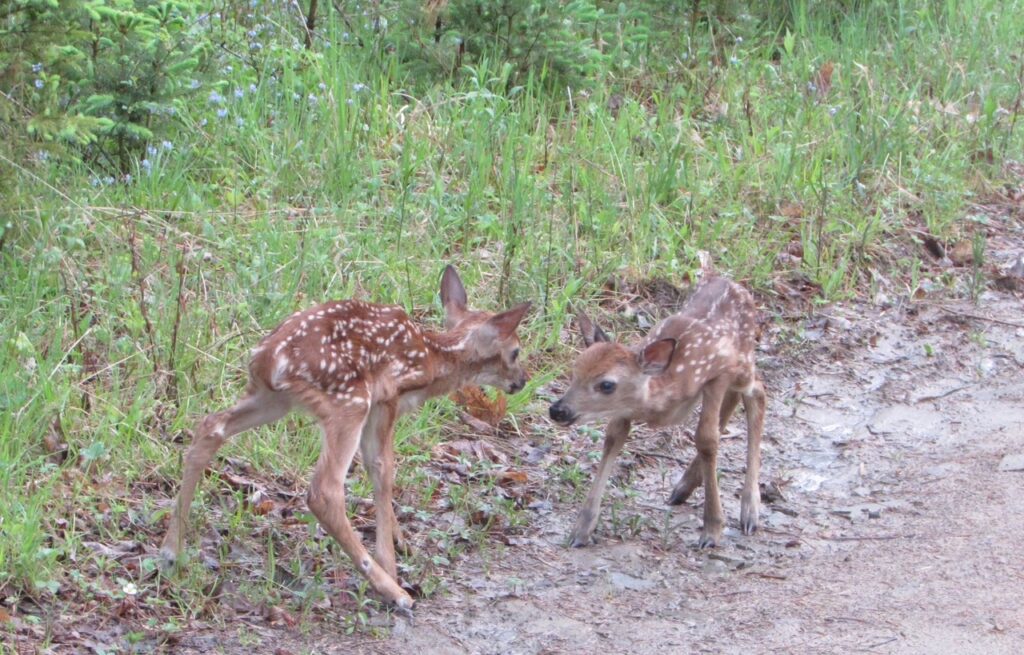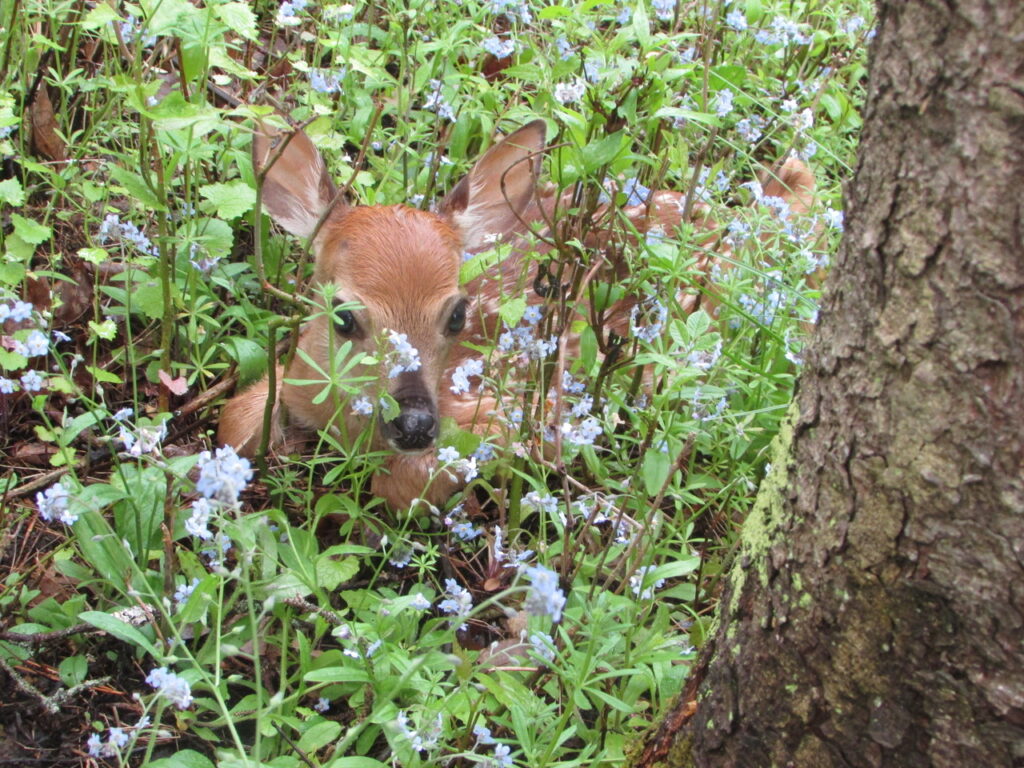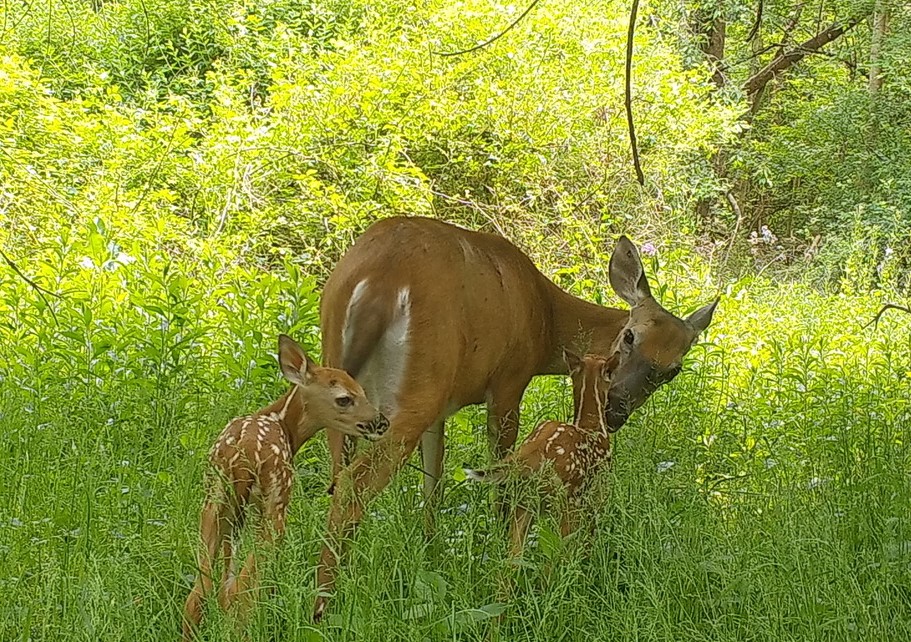“A whitetail doe’s pregnancy is always 200 days, give or take a few”
By Oak Duke,
Turkey hunters sometimes find thoughts of the upcoming deer season under their feet in a literal way.
That’s because at our latitude, up here near the 42nd parallel north, gobbler season and that special time when whitetail fawns first touch the earth are coincidental.
The fawn drop is always proof of when the previous rut occurred because of the constant of the doe’s gestation period of 200 days.
A whitetail doe’s pregnancy is always 200 days, give or take a few.
And when we see our first fawns of the year, it affirms or denies the whitetail Rut or peak breeding timing prognostications of the previous deer season.
Of course there are always outliers, some fawns will be born in early May, and some will be born in July. But for optimal recruitment, whitetails, like most Ungulates, flood the market so to speak, breeding en masse in the fall to overwhelm fawn predation come birthing time.

Contrastingly:
Last gobbler season, there were many reports of fawns mid-May, because the previous rut (2022) was relatively early.
It is a common fallacy, constantly reinforced by well meaning but recalcitrant souls to believe and expect each year’s fawn drop to occur at exactly the same time each year on our calendars.
Just like the rut.
But the changing timing of the fawn drop proves reality each year.
For instance, during the 2022 archery season, the first main rut spike cranked up between Halloween and Election Day.
If we count 200 days from Nov. 1, we land just past the middle of May, and that’s when fawn sightings started coming in 2023, usually photos of the little rascals on trail cameras.

Sightings come in quickly on social media when fawns appear. And not only turkey hunters see the newborns, but any of us who have an eye on the outdoors out the back door, always enjoy the pleasure of seeing a little fawn.
Fawning happens at different times each year, according to the calendar on the wall. Nature and the whitetail breeding cycle evidences their own calendars that sporadically lines up with ours.
Some researchers have determined by studying deer in enclosures that severe winters, or the opposite, mild winters, can have a marginal effect on the gestation period on either side of the base, 200-day number,
When winters are mild, like this year (2023-24,) then we can expect the fawns near the projected due date.
But, if we have a brutal winter as we did years ago when the winters were more “normal,” the fawn drop may be held up a few days.

But for our purposes, a few days doesn’t really matter, because, for one thing, it’s difficult for the average person to judge the age of a fawn, curled up and lying tucked in a tight ball in the middle of a meadow, or out behind the barn, or in a field as we drive past.

Fawns do in fact vary in size and they grown amazingly fast.
And fawns usually don’t start following their moms around for at least a few days, unless they are on the move to a new bedroom.
Counting back from the end of May and early June places the Rut and its lockdown or breeding phase in mid-November as occurred last season (2023.)
If we used a Lunar calendar instead of our modern Gregorian calendar which we began putting up on our walls in the mid 1700’s in preference to the Lunar calendar, we might be able to correctly say that the fawn drop was at the same time each year.
Lunar calendars predated solar calendars and many believe that they are actually more closely tied to the changing of the seasons and nature.
But due to heavy influence from religious and politics, various forms of the Solar calendar were adopted by our predominantly European culture. (Though today’s Islamic calendar remains a Lunar-only calendar. Their months begin on the first sighting of a crescent (New) moon.)
The Hebrew and Chinese calendars are “luni-solar” calendars but still correspond to the moon’s cycles.
Of course whitetails can’t read any of our calendars, no matter what culture or religious denomination.
Deer only respond to nature’s cycles and timing because of their internal clocks, hardwired into their DNA.
Other critters give absolute proof of the effect of the moon on animal behavior; from the obvious breeding rituals of the spawning of the Smallmouth bass, the Horseshoe crab, Sea turtles, and the Grunion, to name a few… all timed and verified every year by the moon – and on Lunar calendars.
Though beliefs and myths that the moon has some magical and mysterious pull or power that effects animal behavior, as it drives the ocean’s tides, are as ubiquitous as they are popular in our current culture.
The actual scientific influence of the moon though is simple, clear-cut, measurable, recordable and not very spooky at all.
Turkey hunters in the spring witness the living effects firsthand, the miraculous annual cycle of the whitetail fawn drop.

Oak Duke/ Wellsville,NY/ May 2024
Whitetail Page: www.facebook.com/Oak.Duke.whitetail.page
Duke’s Honey: www.facebook.com/Dukes-Honey-513590015445371/









